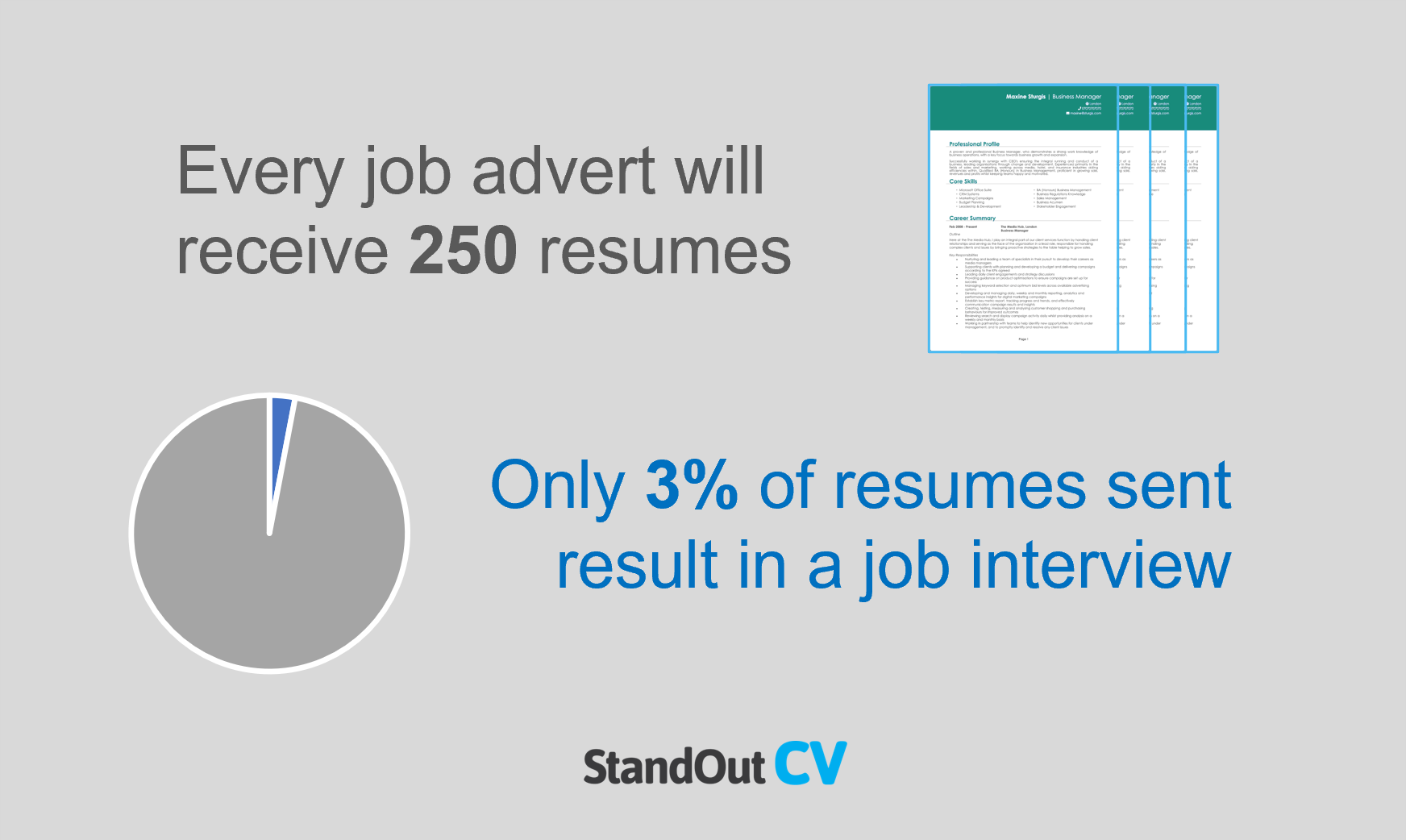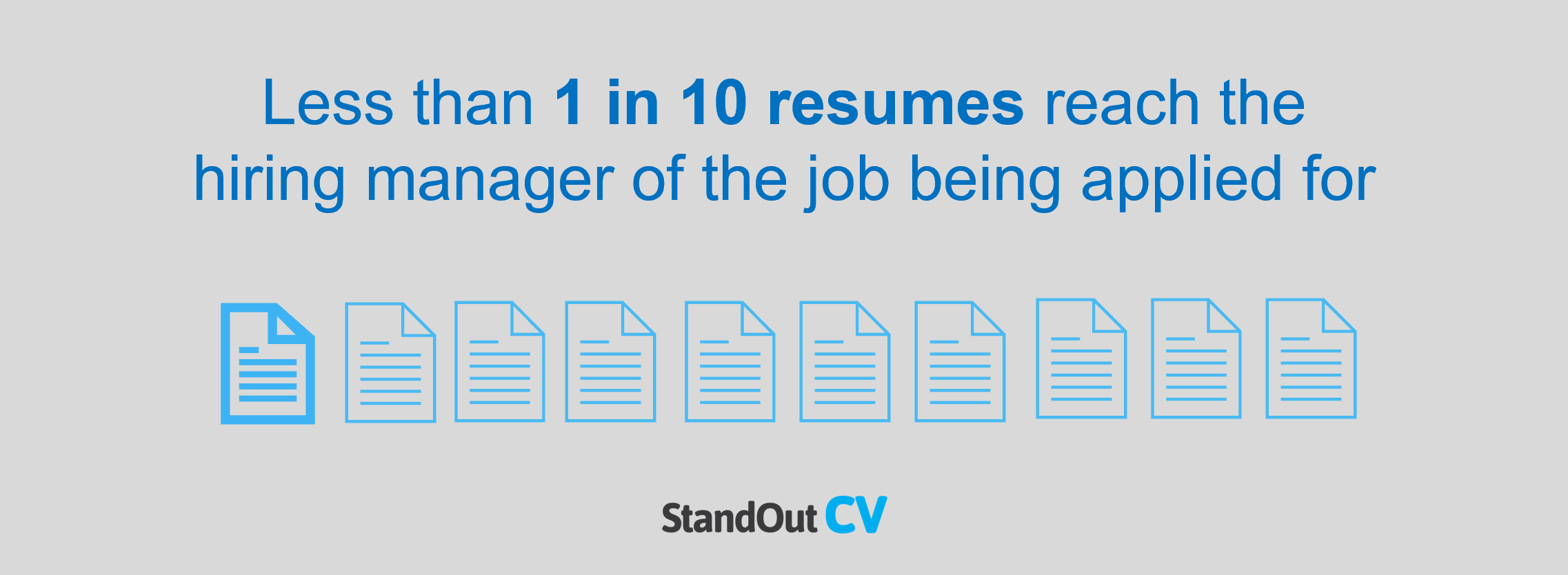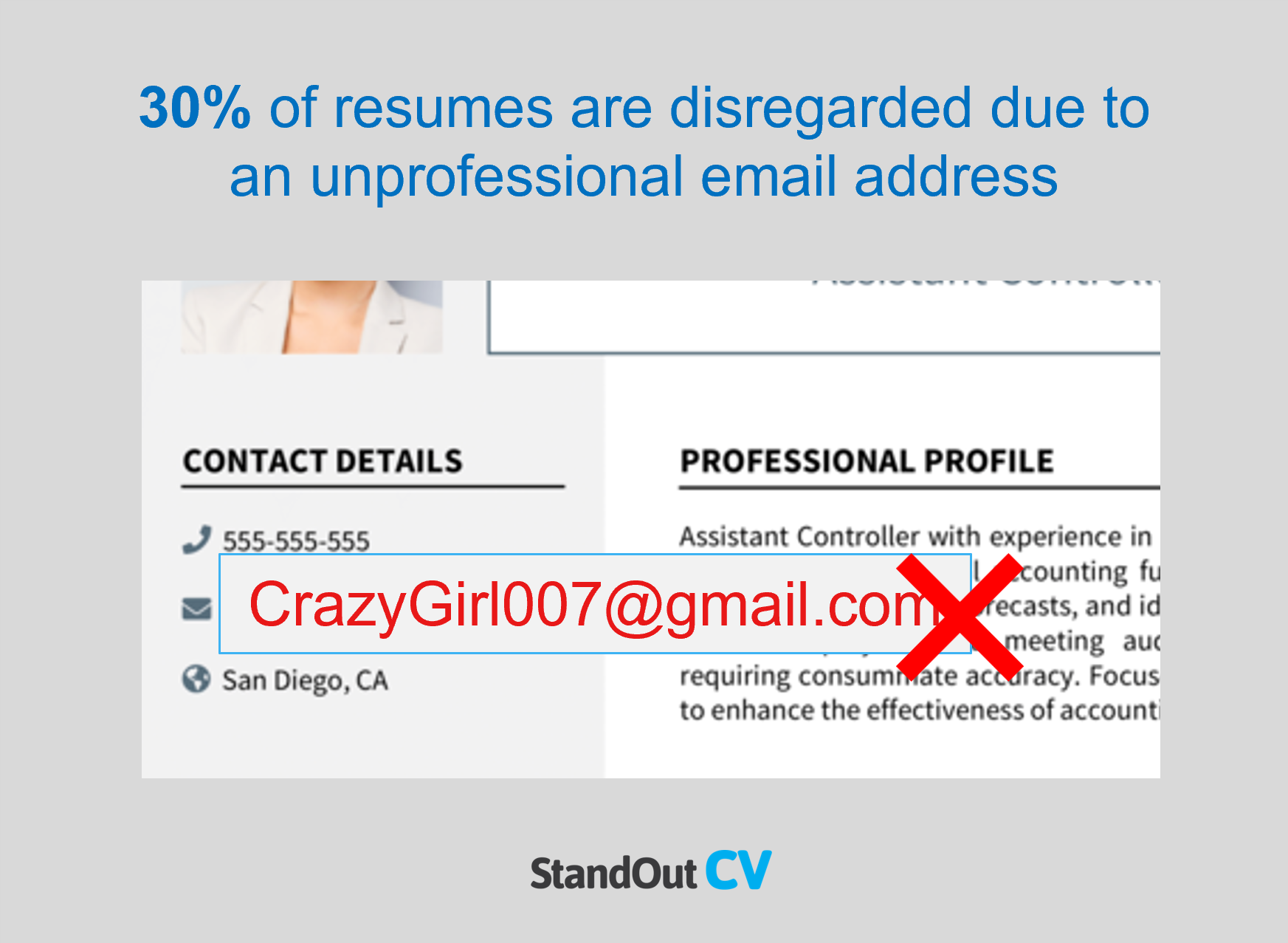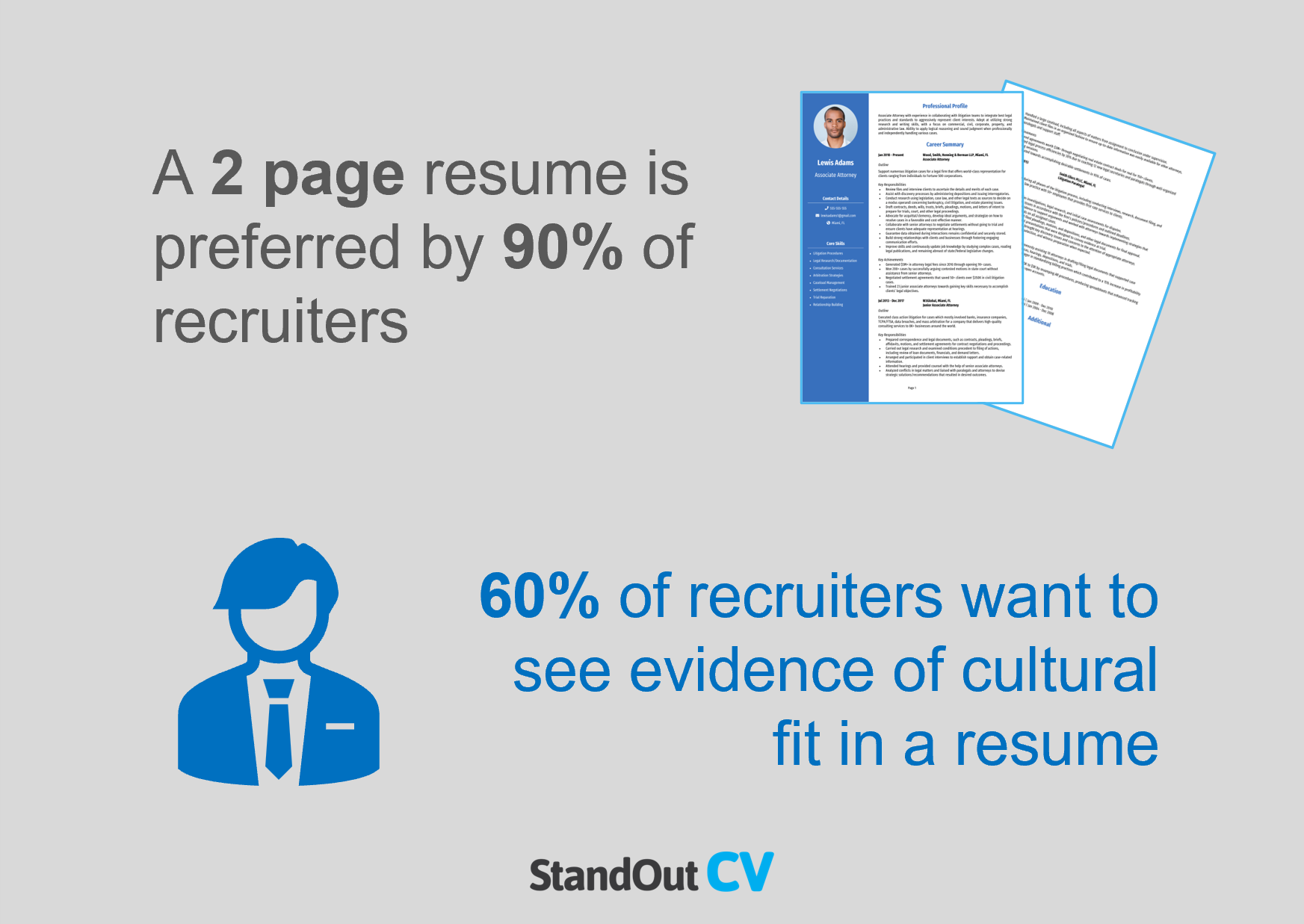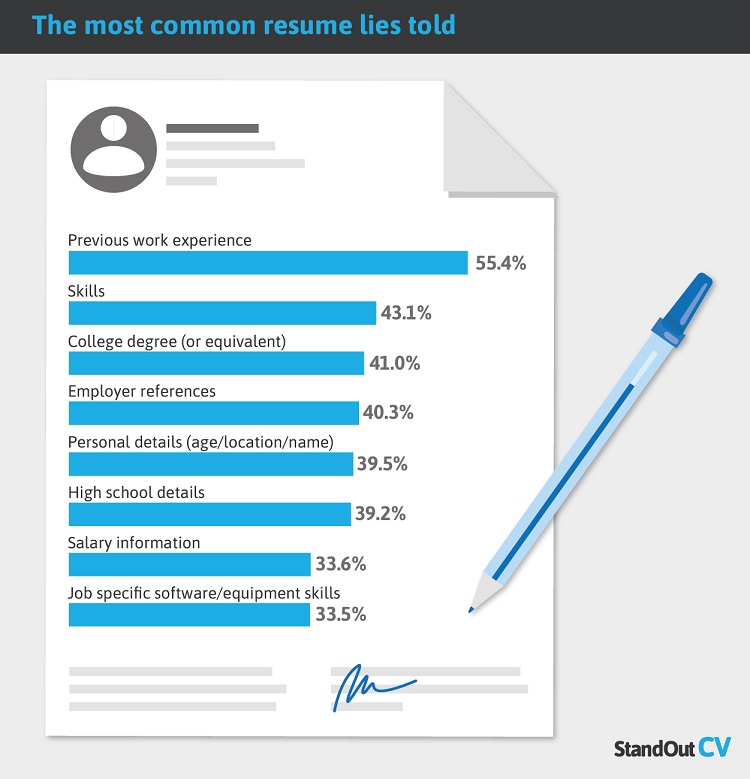Most of us have had to write a resume at some point in our lives, and its one of the most important documents we will ever need.
But how much do we really know about the resume in the USA?
How long are most people’s resumes? How long do recruiters spend reading them? How many resumes does the average job advert receive?
We collated all of the most important resume statistics from across the web, analyzed over 25,000 of our users’ resumes, and surveyed 100 recruiters to bring you the latest facts and figures.
Contents
Key resume statistics 2023
- Every live job advert receives an average of 250 resumes
- Recruiters spend just 6-8 seconds reviewing resumes
- 55% of Americans have lied on their resume at least once
- 75% of resumes are rejected by ATS software and never seen by a human eye
- Less than 1 in 10 resumes reach the hiring manager of advertised jobs
- 3 in 10 resumes are rejected for having an unprofessional email address
- A 2 page resume is preferred by 90% of recruiters
- The average resume length is 1.6 pages long
- Job seekers spend an average of 1 hour and 10 minutes completing their resume
Resumes and job applications
The purpose of any resume is impress at job application and secure an interview. So, we took a deep-dive into the numbers behind job applications and what is happening to our resumes when we send them to employers and recruiters.
How many resumes do job applications receive?
The average job advert in the USA receives 250 resumes from hopeful candidates, according to Glassdoor data.
What percentage of resumes sent receive an interview?
Careers advice site CareerSidekick reports that only 3% of resumes sent to job applications result in a job interview.
How long do recruiters spend reading resumes?
Recruiters spend an average of 6-8 seconds reviewing each resume they receive according to an eye-tracking study carried out by a US job board.
Time spent spent reviewing a resume can vary greatly depending on factors such as industry, job title, and method of job application.
Less than 5% of recruiters will spend more than 1 minute reviewing a resume on the first viewing of it.
Read our detailed study into resume reading time here.
How many resumes do you need to send to get a job?
On average a candidate has to send out 51 resumes to employers to secure a job.
Do companies use ATS to filter resumes?
- Onrec reports that 98% of large organizations use an ATS (applicant tracking system) to review and filer resumes.
- On average 75% of resumes sent into larger businesses are rejected by these systems before a recruiter ever sees them.
- Unsurprisingly only 1 in 4 job seekers feel confident that their resume will get through these systems and be read by a human being.
Do ATS resume filters work?
ERE Media found that their own applicant tracking system rejected 3 out of their 5 top engineers for not having a relevant skill set.
Bersin & associates created an ideal candidate resume for a clinical science role and tested it across a number of different ATS software tools. The resume only scored an average of 43% relevancy for the role.
How many resumes reach the hiring manager of the vacancy being applied for?
When candidates apply for jobs via job a website, less than 1 in 10 resumes reach the hiring manager of the job. The rest are filtered out by a mixture of automated software, assistants and recruiters.
What part of the resume do recruiters value the most?
Recruiters spend 65% of the time spent reading a resume, studying the work experience section
Resume rejection statistics
Why are resumes being rejected across the US and what do the numbers tell us?
How many resumes are rejected?
CareerLauncher data shows us that an average online job vacancy will reject 98% of all resumes that are submitted to it.
LinkedIn tells us that 70% of all resumes are rejected at the initial screening stage (this could either be by a software system or recruiter)
Why are resumes rejected?
The 4 most common reasons for recruiters rejecting a resume are:
- The resume does not suit the job being applied for
- Large unexplained gaps in employment
- Resume being formatted in “functional” format (listing skills only and not including job history)
- The resume summary did not impress the recruiter.
Silly email addresses
According to Motely Fool, 3 in 10 resumes are disregarded by recruiters for having an unprofessional email address. E.g. Badboyz4eva69@hotmail.com
Unsuitable work experience
Work experience which does not match the experience being asked for in the job advert is the cause of 73% of resume rejections.
Qualifications
If a candidate does not have the correct qualifications for the job being applied to, 81% of recruiters will reject the resume. Only 1 in 10 recruiters will forward an under-qualified candidate’s resume through to a hiring manager.
Typos and grammatical errors
Almost 8 in 10 resumes are rejected by hiring managers due to spelling mistakes, bad grammar or typos.
Poor resume design
One in four recruiters would reject a resume if they felt it was badly designed, with poor-readability cited as the most off-putting design flaw.
What recruiters want to see in a resume
What sort of things should you be putting into your resume in order to land interview and secure job offers?
How long should your resume be?
A recent Flexjobs survey showed that recruiters are twice a 2-page resume is preferred by 90% of recruiters and hiring managers. This number was also reflected in a similar survey by British job site; Reed.
100% of recruiters say they would be discouraged from reading a resume that is over 4 pages in length.
A study from TalentWorks showed that resumes between 475-600 words long were the most effective in landing job interviews, but only 23% of resumes in their database were within this range.
Do recruiters prefer tailored resumes?
More than half of recruiters (63%) prefer to see resumes that are tailored to the job being applied for (as oppose to a generic resume used to apply for a variety of jobs)
Skills
On average a recruiter will only consider a resume if it has at least 50% of the requirements being asked for in the job advertisement.
A link to your LinkedIn profile
According to ResumeGo, candidates who include a link to an active LinkedIn profile get 71% more interviews than those who don’t – yet less than half of job seekers do not include one.
Numbers
TalentWorks estimate that including numbers in your resume (to quantify achievements) will increase your chances of landing an interview by 40%.
Cultural fit
According to a Jobvite study 60% of recruiters want to see evidence of cultural fit in a candidate’s resume.
What recruiters do not want to see in a resume
According to the numbers, what details are best kept out of your resume before sending?
Photographs
24% of recruiters surveyed do not want to see a photograph of the candidate on a resume, however 12% say they do, and 44% it had no effect on a hiring decision.
Hobbies and interests
79% of recruiters said they do not read the hobbies and interests section on a resume.
What do people put in their resume
What information do people include in their resumes and how?
Lies
55% of Americans have lied on their resume at least once, meaning that 42.5 million people have lied their way into a job in 2022. Read more about our survey and study into resume lies here.
Personal details
Personal details are a crucial element of any resume, so what exactly are job seekers including in this section of the resume.
- 98% of candidates include a telephone number and 99% include an email address
- 94% of candidates state a general location (town/city) whereas 4% of candidates include a full address
- A quarter of all job seekers include the word “remote” in their location
- Only 1 in 10 job seekers include an external link to a social profile or portfolio.
Photographs
Less than 1 in 4 job seekers add a photo of themselves to their resume.
Software
These are the most commonly mentioned software tools across US resumes are as follows.
| Number | Software |
|---|---|
| 1 | Microsoft Word |
| 2 | Google mail |
| 3 | Microsoft Excel |
| 4 | Slack |
| 5 | Adobe suite |
| 6 | Hubspot |
| 7 | Salesforce |
| 8 | Zoom |
| 9 | Trello |
| 10 | Zendesk |
Skills
These are the top 10 most commonly used resume skills by job seekers, in order of frequency
| Number | Skill |
|---|---|
| 1 | Communication |
| 2 | Organization |
| 3 | Leadership |
| 4 | Customer service |
| 5 | Microsoft office |
| 6 | Administration |
| 7 | HTML |
| 8 | Management |
| 9 | Data |
| 10 | Project management |
Hobbies and interests
Despite 79% of recruiters saying that they do not read them (above section) 1 in 4 people still include their hobbies and interest on their resume.
Only 1 in 10 recruiters claim to be interested in professional awards.
How do people format their resumes?
How are candidates laying out and styling their resumes in today’s job market.
Resume length
The average resume length is 1.6 pages long. Less than 5% of job seekers have a resume which is 5 pages or longer.
When writing about their previous jobs, only 1 in 4 candidates go as far back as 10 years.
Resume font
The most commonly used resume font is Arial, with over 8 in 10 job seekers adopting it in their resume.
Resume colors
Aside from black (text) and white (background) the most popular color to add to a resume is navy blue.
How long do job seekers spend writing their resume?
The average job seeker spends 1 hour and 10 minutes writing their resume.
Less than half of job seekers ask a third party (such as a friend or family member) to proofread their resume before they start applying for jobs.
LinkedIn statistics
Are job seekers utilising the power of LinkedIn? And are they fining success on the platform?
- Job seekers with a comprehensive LinkedIn profile have a 71% higher chance of landing a job interview
- 8 people are hired every minute on the platform
- 72 % of recruiters use LinkedIn to search for candidates and 67% of recruiters say that LinkedIn is the best place to find quality hires.
Cover letter statistics
What do the numbers say about cover letters and whether or not they are needed in the job search?
- According to CareerBuilder, 45% of recruiters would reject a resume if it was not accompanied by a cover letter.
- In contrast to this, more than half of job seekers feel that recruiters do not read cover letters.
Sources and methodology
- Resume analysis – We analyzed 24,993 of our users resumes from inside the StandOut CV builder. The analysis was done anonymously (removing user names and contact details) and only active users were studied to capture data from people who are currently job seeking.
- Recruiter survey – We surveyed 100 recruiters who are actively recruiting candidates for roles in the US job market.
External sources
We also used data from a number of external sources – see full list below.
- Zippia – How long does it take to get a job
- Glassdoor Harris Poll, 2018
- FlexJobs – How long should a resume be
- Reed – How long should a CV be
- LinkedIn – Ultimate hiring statistics
- Career Sidekick – How many applications get an interview
- Capterra – ATS statistics
- Motley Fool – Resume statistics every job seeker should know
- ResumeGo – LinkedIn interview chances
- CareerLauncher – Resume rejection rate online
- LinkedIn – Why resumes get rejected
- Standout CV – Job search statistics
- StandOut CV – Fake references and resume lies
- TalentWorks – The science of job search
- Jobvite – Job seeker survey
- CareerBuilder – Remote work study
- LinkedIn – 5 mind blowing LinkedIn statistics
- Social Shepherd – LinkedIn statistics



